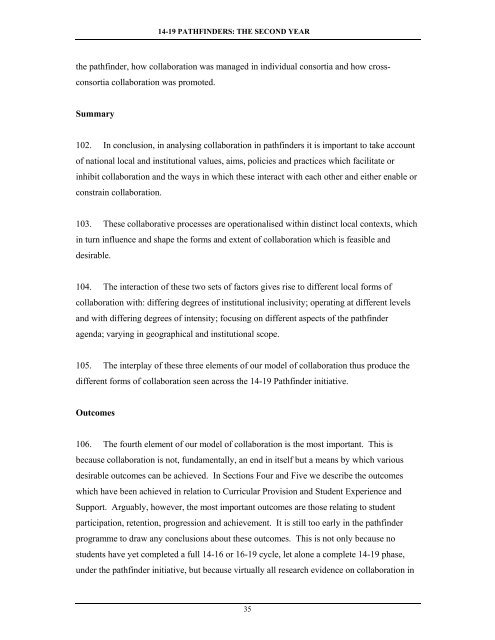Collaborative Approaches to 14-19 Provision - Communities and ...
Collaborative Approaches to 14-19 Provision - Communities and ...
Collaborative Approaches to 14-19 Provision - Communities and ...
- No tags were found...
Create successful ePaper yourself
Turn your PDF publications into a flip-book with our unique Google optimized e-Paper software.
<strong>14</strong>-<strong>19</strong> PATHFINDERS: THE SECOND YEARthe pathfinder, how collaboration was managed in individual consortia <strong>and</strong> how crossconsortiacollaboration was promoted.Summary102. In conclusion, in analysing collaboration in pathfinders it is important <strong>to</strong> take accoun<strong>to</strong>f national local <strong>and</strong> institutional values, aims, policies <strong>and</strong> practices which facilitate orinhibit collaboration <strong>and</strong> the ways in which these interact with each other <strong>and</strong> either enable orconstrain collaboration.103. These collaborative processes are operationalised within distinct local contexts, whichin turn influence <strong>and</strong> shape the forms <strong>and</strong> extent of collaboration which is feasible <strong>and</strong>desirable.104. The interaction of these two sets of fac<strong>to</strong>rs gives rise <strong>to</strong> different local forms ofcollaboration with: differing degrees of institutional inclusivity; operating at different levels<strong>and</strong> with differing degrees of intensity; focusing on different aspects of the pathfinderagenda; varying in geographical <strong>and</strong> institutional scope.105. The interplay of these three elements of our model of collaboration thus produce thedifferent forms of collaboration seen across the <strong>14</strong>-<strong>19</strong> Pathfinder initiative.Outcomes106. The fourth element of our model of collaboration is the most important. This isbecause collaboration is not, fundamentally, an end in itself but a means by which variousdesirable outcomes can be achieved. In Sections Four <strong>and</strong> Five we describe the outcomeswhich have been achieved in relation <strong>to</strong> Curricular <strong>Provision</strong> <strong>and</strong> Student Experience <strong>and</strong>Support. Arguably, however, the most important outcomes are those relating <strong>to</strong> studentparticipation, retention, progression <strong>and</strong> achievement. It is still <strong>to</strong>o early in the pathfinderprogramme <strong>to</strong> draw any conclusions about these outcomes. This is not only because nostudents have yet completed a full <strong>14</strong>-16 or 16-<strong>19</strong> cycle, let alone a complete <strong>14</strong>-<strong>19</strong> phase,under the pathfinder initiative, but because virtually all research evidence on collaboration in35
















